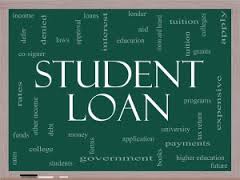Financial Aid Student Guide
This student guide is designed to help you understand what financial aid may be available to you and what you can do so that you may receive that financial aid. If this information does not answer your questions, our staff is available to assist you. Please call us at (619) 660-4201 or visit the Financial Aid Office in the One-Stop Student Services Center (Building A300) near the corner of Fury Lane and Rancho San Diego Parkway.
There are generally three types of financial aid: GRANTS — money that does not have to be repaid (unless you drop from school or owe a refund), including scholarships; EMPLOYMENT — money you can earn through part-time work while attending school and LOANS — money you borrow that you must pay back in the future. Since many students are eligible for more than one type of financial aid, we offer a “package” of aid.
GRANTS
– Federal Pell Grant
The Federal Pell Grant is available for you as an undergraduate until you receive your first bachelor’s degree or have received 12 full-time semesters of Pell Grant aid. Federal Pell Grants range from $657 to $6195 per academic year depending upon your Expected Family Contribution (EFC), your cost of attendance (COA), and your enrollment status. Effective July 1, 2012, the maximum lifetime eligibility to receive a Pell Grant is 12 full-time equivalent semesters (approximately 6 years). This limit includes all prior semesters of Pell Grant aid received at all prior schools. After receiving 12 full-time equivalent semesters of Pell grant, eligibility for Pell grant ends. For more information go to Federal Student Aid website.
FATV VIDEO - "WHAT IS PELL GRANT"
– Federal Supplemental Educational Opportunity Grant (FSEOG)
FSEOG is a federal grant program for undergraduate students who have “exceptional financial need,” and have not received a bachelor’s degree. First priority will be given to students enrolled full-time who receive a Federal Pell Grant and show exceptional financial need on a first-come, first-served basis. At Cuyamaca College, grant amounts may range from $100 to $500 per academic year. For more information, go to Federal Student Aid website.
FATV VIDEO - "WHAT IS FSEOG"
– Cal Grants
Cal Grants are state grants managed by the California Student Aid Commission (CSAC) and are for California residents or eligible non-residents who show financial need, meet the program and academic requirements, and apply on time. There are two types of Cal Grants: entitlement and competitive.
-
Cal Grant - Entitlement is an award that is guaranteed for every high school senior or recent high school graduate that meets the program and academic requirements (at least a 3.0 GPA for Cal Grant A; at least a 2.0 GPA for Cal Grant B), meets the family income and asset ceilings, and applies on time.
-
Cal Grant - Competitive is for those that are not high school seniors or recent high school graduates. These awards are not guaranteed and only a limited number are available each year. Half of the competitive awards are offered to students who meet the March 2 filing deadline. The other half of the competitive awards are offered to students who are enrolled at a California Community College for the fall term and have a GPA reported by the September 2 filing deadline.
– Cal Grant A
Cal Grant A is an entitlement or a competitive grant. It is targeted toward students with high GPAs and moderate income. This grant pays for tuition at tuition-charging institutions. You cannot receive a Cal Grant A while enrolled at a community college. Community college students can have their grants put on “community college reserve” for up to three years. Once you transfer to a tuition-charging institution your grant can be used. The maximum award is $9,084 for students attending independent colleges and universities, up to $12,294 for University of California students, and up to $5,472 for California State University students.
– Cal Grant B
Cal Grant B is an entitlement or a competitive grant. It provides a living allowance for low-income students and tuition payment for students’ second through fourth year of study at tuition-charging institutions. For 2019-2020, the maximum living allowance has been set at $1,672.
– Cal Grant C
Cal Grant C is a competitive grant for vocational students who are enrolled in programs from nine months to two years in length. Cal Grant C provides $547 a year for books, tools & equipment. Cal Grant C pays up to $2,462 for tuition at tuition-charging institutions.
FATV VIDEO - "WHAT IS CAL GRANT"
A grant program specifically aimed at Cal Grant B recipients who are attending full time. Approximate yearly amount is $1000. This program is funded by the State of California and administered by the State Chancellor’s Office.
FATV VIDEO - "WHAT IS THE SSCG"
EOPS is a state funded program designed primarily for the recruitment and retention of California residents who are considered educationally disadvantaged (as determined by EOPS), have not completed more than 70 units of degree applicable coursework, are enrolled full-time (12 units or more), and qualify for the Board of Governors Fee Waiver, method A or B. For more information, go to the EOP Webpage.
FATV VIDEO - "WHAT IS EOPS"
– Cooperative Agencies Resources for Education (CARE)
CARE is a state funded program designed to recruit and assist single parent recipients of Temporary Assistance for Needy Families, (TANF), or Cal Works who would like to attend college and are EOPS eligible. CARE provides support services and/or grant funds to enable academic success and to assist students in attaining their career and vocational goals. For more information, go to the Care Webpage.
FATV VIDEO - "WHAT IS THE CARE PROGRAM"
– Chafee Grant
The California Chafee Grant Program is available for current or former foster youth to use for career and technical training or college courses. The maximum grant amount is $5000 per year. Students must be enrolled in six or more units each semester to be eligible for the Chafee Grant. For questions regarding eligibility please contact Pam Fleming in the Financial Aid Office at 619-660-4291.
FATV VIDEO - "WHAT'S A CHAFEE GRANT"
– Child Development Grant
The Child Development Grant program is administered by the California Student Aid Commission (CSAC). The program is designed for students who are attending a California Community College or four-year institution and pursuing a Child Development permit to teach or supervise in licensed children’s centers. At community colleges, you can receive up to $1000 each academic year and you must sign a service commitment agreement to provide one full year of service in a licensed children’s center for every year you receive the grant. For more information, go to the California Student Aid and search “Child Development Grant.”
– Bureau of Indian Affairs Higher Education Grants (BIA)
Individual tribes may provide money to help enrolled members pay for college. The amounts of the grants vary according to the individual tribe. To apply, contact your tribe. You may also contact The Bureau of Indian Affairs Tribal Operations in Sacramento, at (916) 930-3680 or Riverside, at (951) 276-6624, or the San Diego Indian Human Resource Center, Inc. at (619) 281-5964 to obtain tribe contact information. Complete appropriate items and send it to the Financial Aid Office. A FAFSA must also be completed. Watch for deadlines—each tribal agency establishes its own deadline.
– California College Promise Grant (CCPG)
Formerly the Board of Governors Fee Waiver program (BOG)
FATV VIDEO - WHAT IS THE CALIFORNIA PROMISE GRANT
SCHOLARSHIPS
 important to research and apply for any available scholarship. For additional scholarship search information contact the Cuyamaca College Scholarship Specialist Ernie Williams at (619) 660-4537, or visit the Cuyamaca College Scholarship Website.
important to research and apply for any available scholarship. For additional scholarship search information contact the Cuyamaca College Scholarship Specialist Ernie Williams at (619) 660-4537, or visit the Cuyamaca College Scholarship Website.EMPLOYMENT
The Work-Study programs give students the opportunity to earn part or all of their financial need by working on campus or off campus in community service positions while they are in school. Examples of the jobs available are: teacher’s aide, clerk, grounds person, custodian, and lab assistant. Your wage will be determined by the type and difficulty of the work that you choose.
– Student Employment
The Career Center helps students find part-time employment in the community. All students enrolled at Cuyamaca College are eligible for Student Placement Center services. For more information visit the Career Center Services website.
FATV VIDEO - "WHAT IS A FEDERAL WORK-STUDY JOB?"
LOANS
Cuyamaca College participates in the William D. Ford Federal Direct Loan Program by offering subsidized and unsubsidized Direct Student Loans (Direct Loans). Federal Direct Student Loans, subsidized or unsubsidized, are low-interest rate loans made to students by the federal government.
- Direct Subsidized Loan: These loans are available
 to students who demonstrate financial need. The federal government pays the interest on this loan while you are in college and during deferment periods.
to students who demonstrate financial need. The federal government pays the interest on this loan while you are in college and during deferment periods. - Direct Unsubsidized Loan: These loans are available to all eligible students and are not based on financial need. You are responsible for all interest payments (or capitalization of interest) from the date the loan is disbursed.
– The interest rate: As of July 1, 2017 the interest rate for a subsidized loan is fixed @ 4.45% for subsidized loans disbursed from July 1, 2017 to June 30, 2018. The interest rate for unsubsidized loans is fixed at 4.45%.
– The loan amounts: Freshmen students may borrow a base amount of $3,500 (subsidized and/or unsubsidized); sophomore students may borrow a base amount of $4,500 (subsidized and/or unsubsidized) per academic year. Loan amounts for one semester only are one-half (1/2) the maximum yearly loan amount, not to exceed need or cost of attendance.
FATV VIDEO - "LOAN BORROWER RESPONSIBILITIES"
(BACK TO TOP) (BACK TO TABLE OF CONTENTS)





